sensor VOLVO XC90 2006 Owner's Manual
[x] Cancel search | Manufacturer: VOLVO, Model Year: 2006, Model line: XC90, Model: VOLVO XC90 2006Pages: 256, PDF Size: 6.87 MB
Page 111 of 256
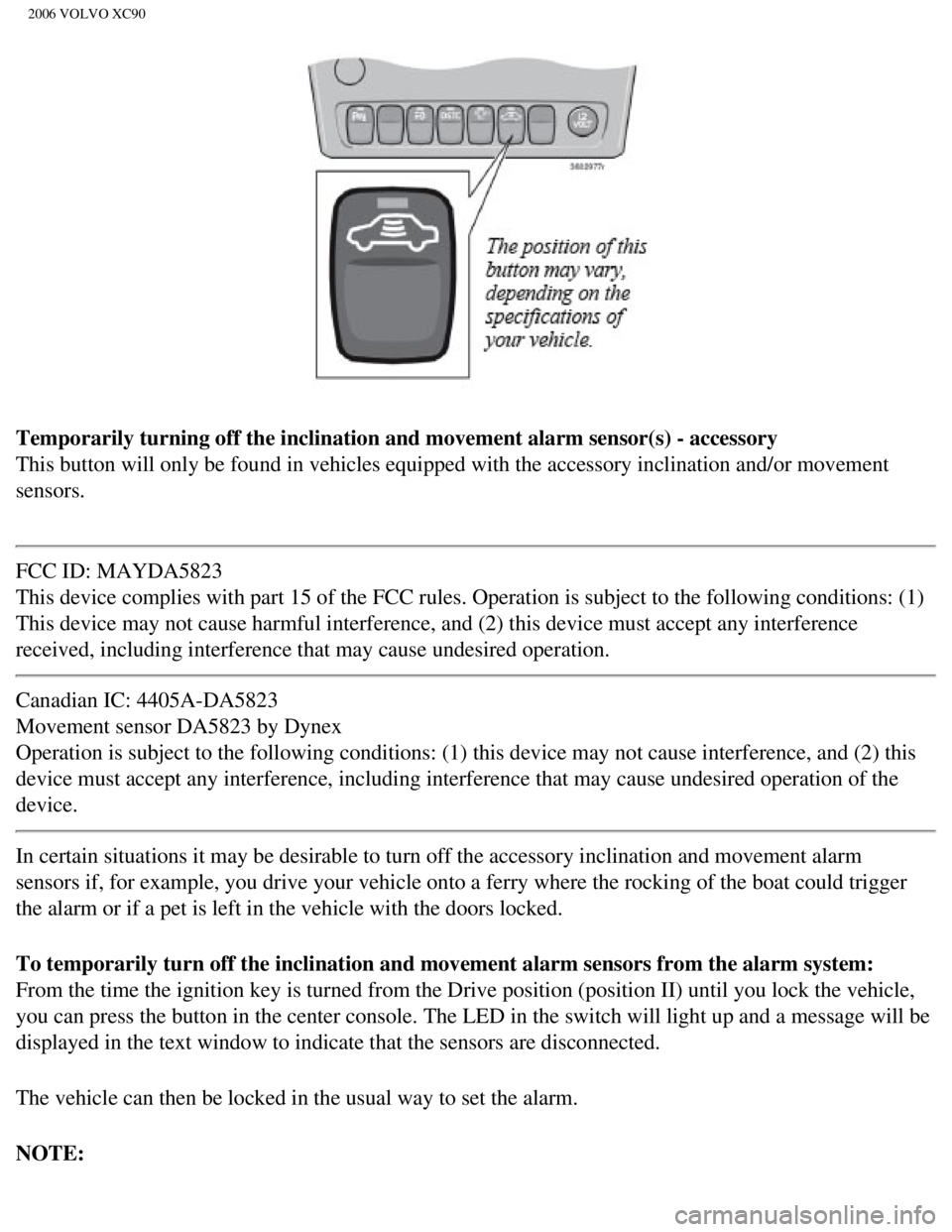
2006 VOLVO XC90
Temporarily turning off the inclination and movement alarm sensor(s) -\
accessory
This button will only be found in vehicles equipped with the accessory i\
nclination and/or movement
sensors.
FCC ID: MAYDA5823
This device complies with part 15 of the FCC rules. Operation is subject\
to the following conditions: (1)
This device may not cause harmful interference, and (2) this device mu\
st accept any interference
received, including interference that may cause undesired operation.
Canadian IC: 4405A-DA5823
Movement sensor DA5823 by Dynex
Operation is subject to the following conditions: (1) this device may \
not cause interference, and (2) this
device must accept any interference, including interference that may cau\
se undesired operation of the
device.
In certain situations it may be desirable to turn off the accessory incl\
ination and movement alarm
sensors if, for example, you drive your vehicle onto a ferry where the r\
ocking of the boat could trigger
the alarm or if a pet is left in the vehicle with the doors locked.
To temporarily turn off the inclination and movement alarm sensors from \
the alarm system:
From the time the ignition key is turned from the Drive position (posit\
ion II) until you lock the vehicle,
you can press the button in the center console. The LED in the switch wi\
ll light up and a message will be
displayed in the text window to indicate that the sensors are disconnect\
ed.
The vehicle can then be locked in the usual way to set the alarm.
NOTE:
file:///K|/ownersdocs/2006/2006_XC90/06xc90_05.htm (12 of 13)12/30/200\
6 5:32:43 PM
Page 112 of 256
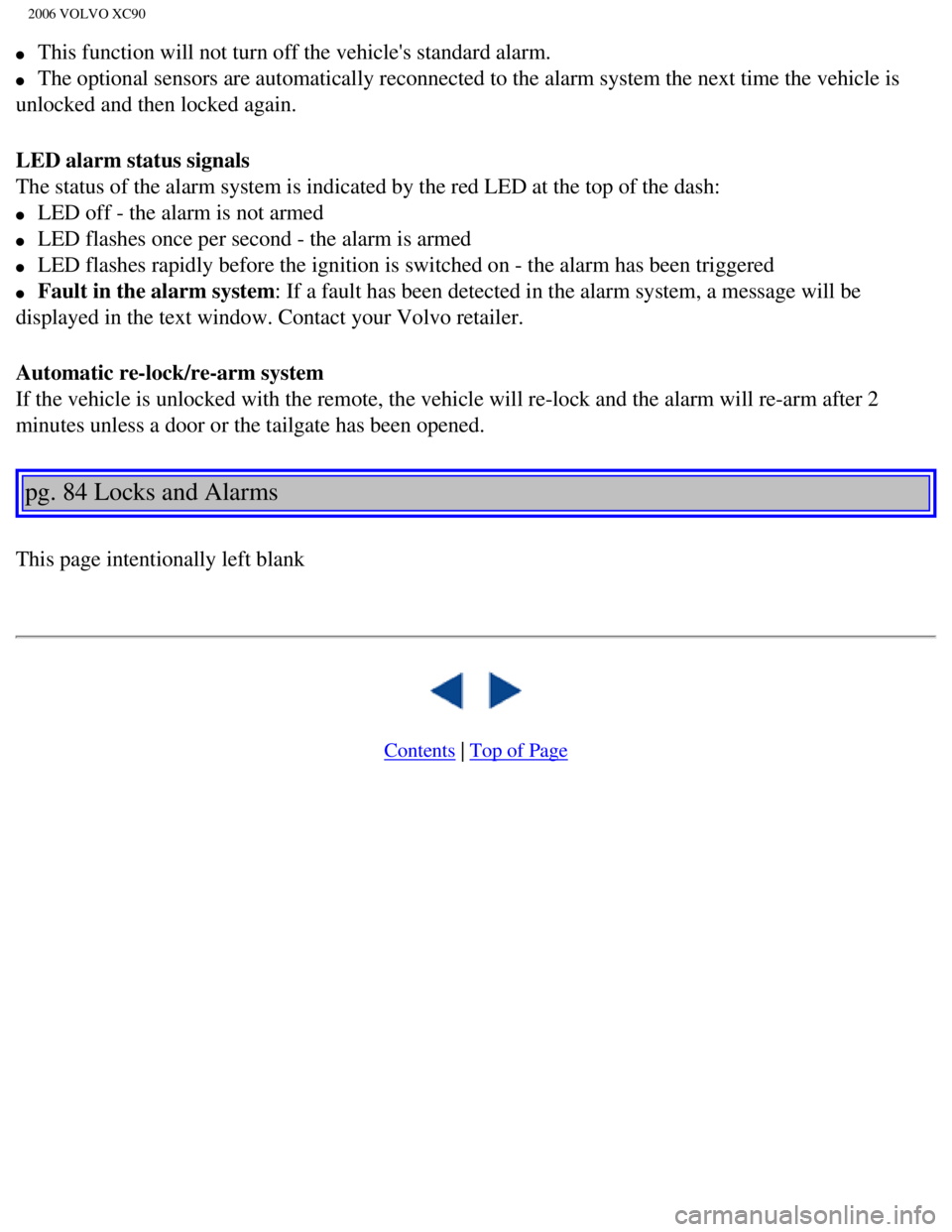
2006 VOLVO XC90
l This function will not turn off the vehicle's standard alarm.
l The optional sensors are automatically reconnected to the alarm system t\
he next time the vehicle is
unlocked and then locked again.
LED alarm status signals
The status of the alarm system is indicated by the red LED at the top of\
the dash:
l LED off - the alarm is not armed
l LED flashes once per second - the alarm is armed
l LED flashes rapidly before the ignition is switched on - the alarm has b\
een triggered
l Fault in the alarm system: If a fault has been detected in the alarm system, a message will be
displayed in the text window. Contact your Volvo retailer.
Automatic re-lock/re-arm system
If the vehicle is unlocked with the remote, the vehicle will re-lock and\
the alarm will re-arm after 2
minutes unless a door or the tailgate has been opened.
pg. 84 Locks and Alarms
This page intentionally left blank
Contents | Top of Page
file:///K|/ownersdocs/2006/2006_XC90/06xc90_05.htm (13 of 13)12/30/200\
6 5:32:43 PM
Page 114 of 256

2006 VOLVO XC90
pg. 86 Starting and driving
Refueling
ENGINE OIL
Although some oil consumption occurs during normal engine operation, mor\
e oil is consumed when the
engine is new as the internal parts generate higher friction while weari\
ng-in to each other. From the time
the engine is new until the first maintenance is performed, the oil cons\
umption could be higher than
normal. For this reason, it is especially important to check the oil eve\
ry time you refuel your vehicle
during this period. See
page 149.
Fuel requirements
Octane rating
Volvo engines are designed for optimum performance on unleaded premium g\
asoline with an AKI
octane rating of 91 or above. AKI (ANTI KNOCK INDEX) is an average of \
the Research Octane
Number, RON, and the Motor Octane Number, MON. ((RON + MON)/2). The \
minimum octane
requirement is AKI 87 (RON 91).
Deposit control gasoline (detergent additives)
Volvo recommends the use of detergent gasoline to control engine deposit\
s. Detergent gasoline is
effective in keeping injectors and intake valves clean. Consistent use o\
f deposit control gasolines will
help ensure good driveability and fuel economy. If you are not sure whet\
her the gasoline contains
deposit control additives, check with the service station operator.
NOTE: Volvo does not recommend the use of external fuel injector cleaning syst\
ems.
Unleaded fuel
Each Volvo has a three-way catalytic converter and must use only unleade\
d gasoline. U.S. and Canadian
regulations require that pumps delivering unleaded gasoline be labelled \
"UNLEADED". Only these
pumps have nozzles which fit your vehicle's filler inlet. It is unlawful\
to dispense leaded fuel into a
vehicle labelled "unleaded gasoline only". Leaded gasoline damages the t\
hree-way catalytic converter
and the heated oxygen sensor system. Repeated use of leaded gasoline wil\
l lessen the effectiveness of
the emission control system and could result in loss of emission warrant\
y coverage. State and local
vehicle inspection programs will make detection of misfueling easier, po\
ssibly resulting in emission test
failure for misfueled vehicles.
NOTE: Some U.S. and Canadian gasolines contain an octane enhancing additive ca\
lled methyl-
cyclopentadienyl manganese tricarbonyl (MMT). If such fuels are used, \
your Emission Control System
performance may be affected, and the Check Engine Light (malfunction in\
dicator lamp) located on your
instrument panel may light. If this occurs, please return your vehicle t\
o an authorized Volvo retailer for
maintenance.
file:///K|/ownersdocs/2006/2006_XC90/06xc90_06a.htm (2 of 14)12/30/200\
6 5:32:44 PM
Page 130 of 256

2006 VOLVO XC90
the difference in speed is immediately detected. This triggers the Anti-\
lock Brake System, which brakes
the spinning wheel until the difference in rotational speed is corrected\
.
TC is most active at low speeds, and a pulsating sound will be audible w\
hen the system is regulating
wheel spin. This is quite normal.
This is one of the DSTC system's permanent functions and is not affected\
when the DSTC button on the
center control panel is pressed.
2. Spin control (SC)
The spin control function is designed to help prevent the drive wheels f\
rom spinning while the vehicle is
accelerating. This is done by temporarily reducing engine torque to the \
drive wheels, which helps
improve tractive force.
Under certain circumstances, such as when driving with snow chains, or d\
riving in deep snow or loose
sand, it may be advisable to temporarily switch off this function for ma\
ximum tractive force. This is
done by pressing the DSTC button on the center control panel for at leas\
t a half a second.
When the SC function has been switched off:
l The text window will briefly display "DSTC SPIN CONTROL OFF"
l The LED in the DSTC button will be off.
3. Active Yaw Control (AYC)
This function helps maintain directional stability, for example when cor\
nering, by braking one or more
of the wheels if the vehicle shows a tendency to skid or slide laterally\
. This is done by activating the
Anti-lock Braking System. A pulsating sound will be audible when the fun\
ction is active, which is quite
normal. If you apply the brakes while this function is active, the brake\
pedal will feel stiffer than usual.
This is also one of the DSTC system's permanent functions and is not aff\
ected when the DSTC button on
the center control panel is pressed.
4. Roll Stability Control (RSC)
RSC utilizes a gyro-sensor to monitor the vehicle's angle of inclination\
, and the rate at which this angle
changes. If necessary, RSC activates the Anti-lock Brake System to brake\
one or more of the wheels to
help maintain stability. A pulsating sound will be audible when the func\
tion is active, which is quite
normal. If you apply the brakes while this function is active, the brake\
pedal will feel stiffer than usual.
This is one of the DSTC system's permanent functions and is not affected\
when the DSTC button on the
center control panel is pressed.
The DSTC button
The DSTC button in the center control panel is used to switch the Spin C\
ontrol (SC) function on or off.
file:///K|/ownersdocs/2006/2006_XC90/06xc90_06b.htm (4 of 18)12/30/200\
6 5:32:46 PM
Page 132 of 256
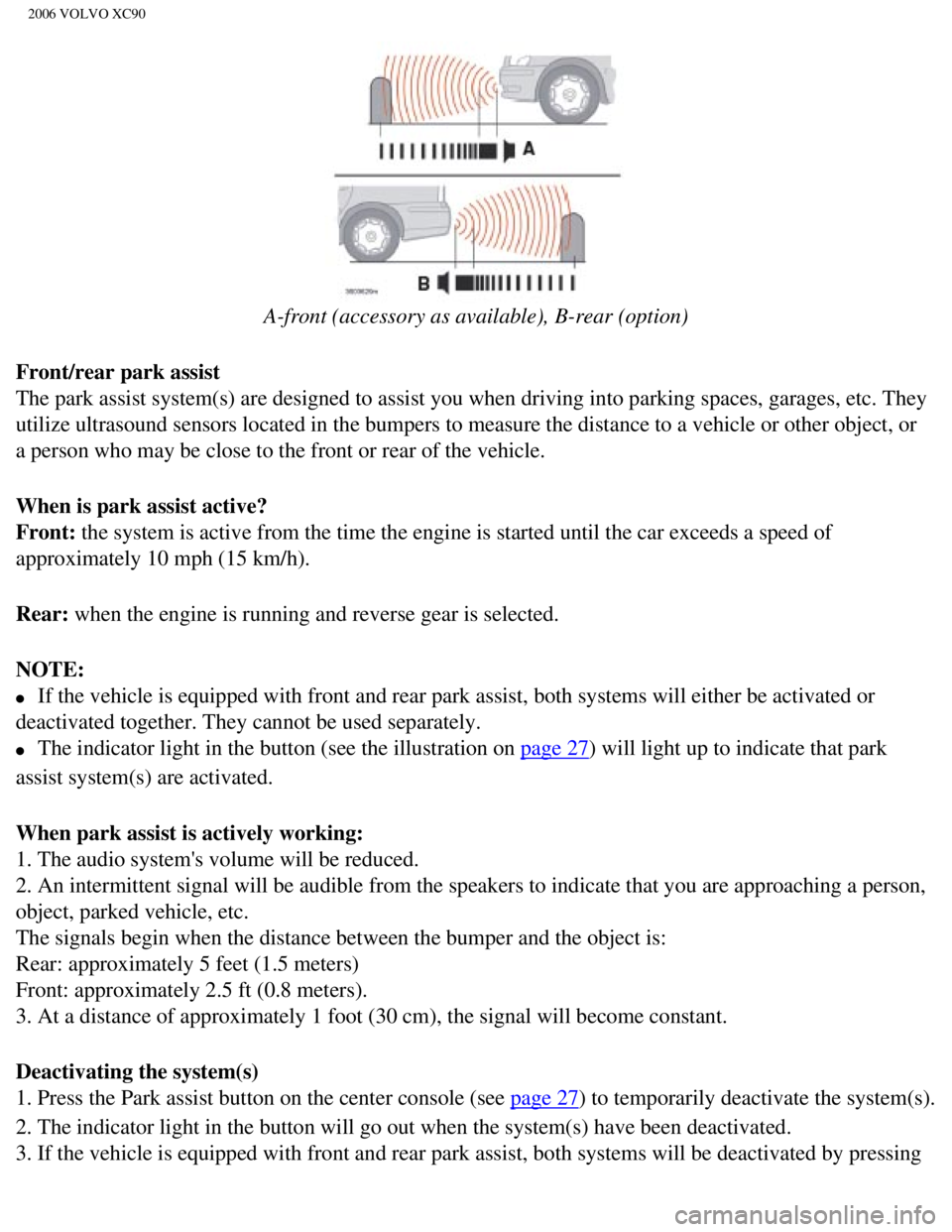
2006 VOLVO XC90
A-front (accessory as available), B-rear (option)
Front/rear park assist
The park assist system(s) are designed to assist you when driving into\
parking spaces, garages, etc. They
utilize ultrasound sensors located in the bumpers to measure the distanc\
e to a vehicle or other object, or
a person who may be close to the front or rear of the vehicle.
When is park assist active?
Front: the system is active from the time the engine is started until the car \
exceeds a speed of
approximately 10 mph (15 km/h).
Rear: when the engine is running and reverse gear is selected.
NOTE:
l If the vehicle is equipped with front and rear park assist, both systems\
will either be activated or
deactivated together. They cannot be used separately.
l The indicator light in the button (see the illustration on page 27) will light up to indicate that park
assist system(s) are activated.
When park assist is actively working:
1. The audio system's volume will be reduced.
2. An intermittent signal will be audible from the speakers to indicate \
that you are approaching a person,
object, parked vehicle, etc.
The signals begin when the distance between the bumper and the object is\
:
Rear: approximately 5 feet (1.5 meters)
Front: approximately 2.5 ft (0.8 meters).
3. At a distance of approximately 1 foot (30 cm), the signal will beco\
me constant.
Deactivating the system(s)
1. Press the Park assist button on the center console (see
page 27) to temporarily deactivate the system(s).
2. The indicator light in the button will go out when the system(s) ha\
ve been deactivated.
3. If the vehicle is equipped with front and rear park assist, both syst\
ems will be deactivated by pressing
file:///K|/ownersdocs/2006/2006_XC90/06xc90_06b.htm (6 of 18)12/30/200\
6 5:32:46 PM
Page 133 of 256
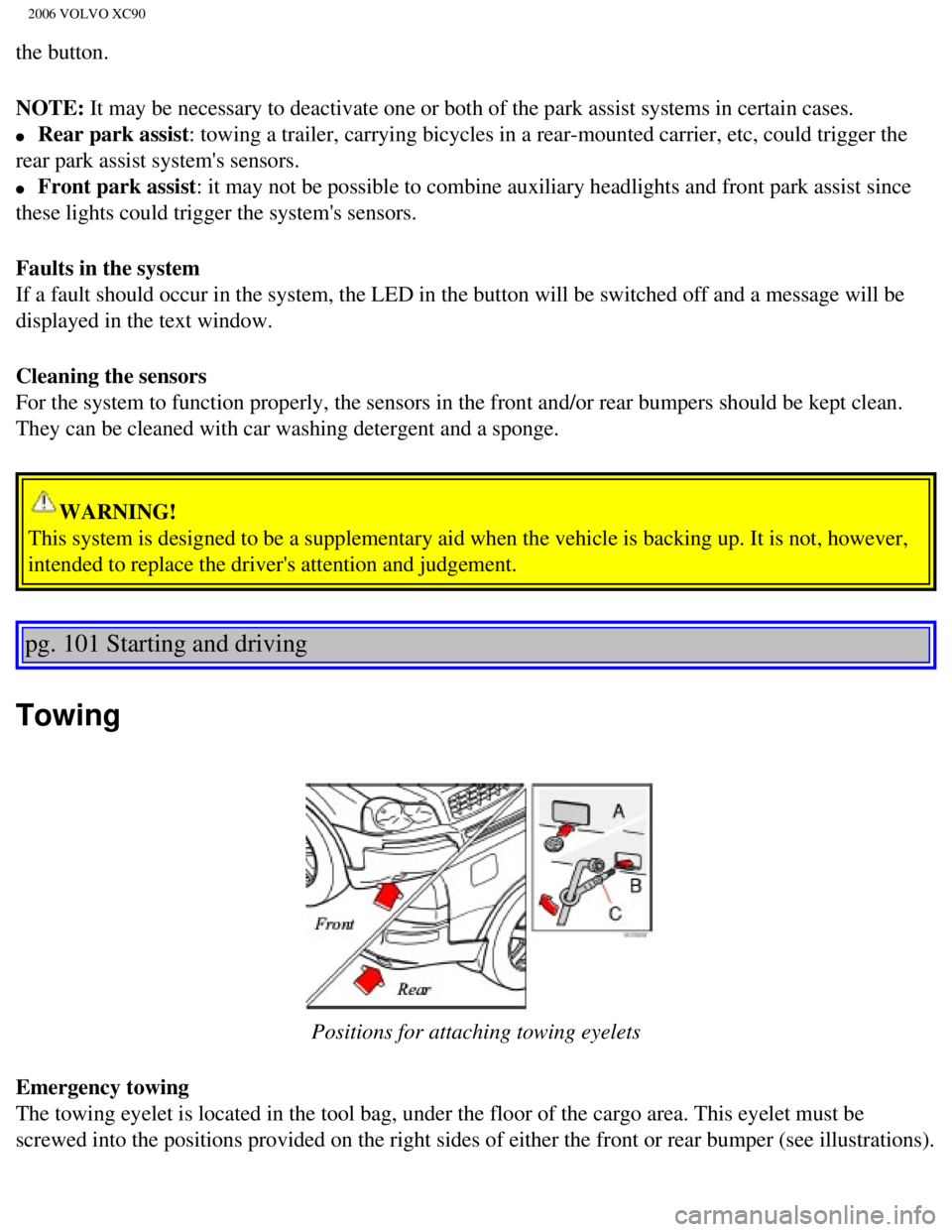
2006 VOLVO XC90
the button.
NOTE: It may be necessary to deactivate one or both of the park assist system\
s in certain cases.
l Rear park assist: towing a trailer, carrying bicycles in a rear-mounted carrier, etc, co\
uld trigger the
rear park assist system's sensors.
l Front park assist: it may not be possible to combine auxiliary headlights and front park \
assist since
these lights could trigger the system's sensors.
Faults in the system
If a fault should occur in the system, the LED in the button will be swi\
tched off and a message will be
displayed in the text window.
Cleaning the sensors
For the system to function properly, the sensors in the front and/or rea\
r bumpers should be kept clean.
They can be cleaned with car washing detergent and a sponge.
WARNING!
This system is designed to be a supplementary aid when the vehicle is ba\
cking up. It is not, however,
intended to replace the driver's attention and judgement.
pg. 101 Starting and driving
Towing
Positions for attaching towing eyelets
Emergency towing
The towing eyelet is located in the tool bag, under the floor of the car\
go area. This eyelet must be
screwed into the positions provided on the right sides of either the fro\
nt or rear bumper (see illustrations).
file:///K|/ownersdocs/2006/2006_XC90/06xc90_06b.htm (7 of 18)12/30/200\
6 5:32:46 PM
Page 158 of 256
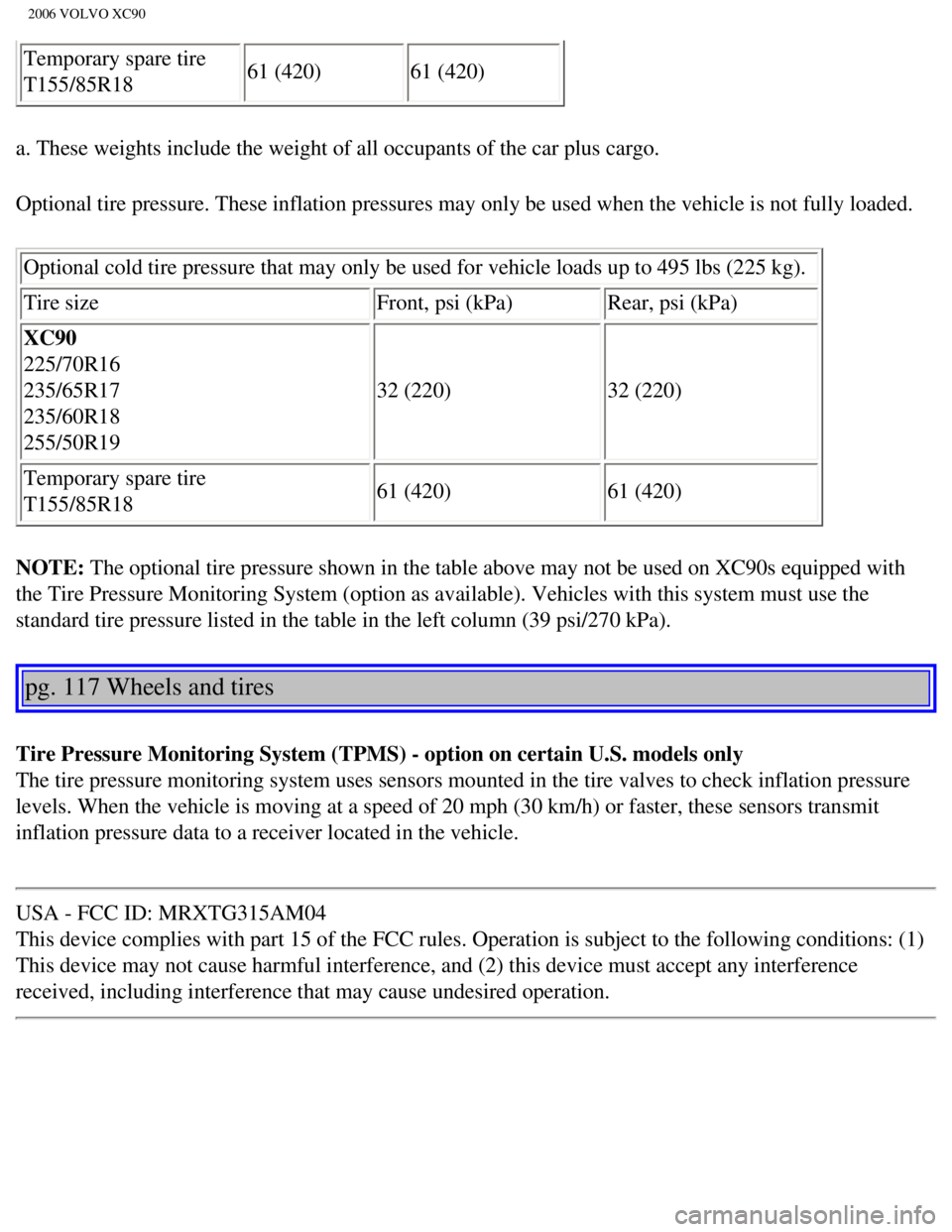
2006 VOLVO XC90
Temporary spare tire
T155/85R18 61 (420)
61 (420)
a. These weights include the weight of all occupants of the car plus car\
go.
Optional tire pressure. These inflation pressures may only be used when \
the vehicle is not fully loaded. Optional cold tire pressure that may only be used for vehicle loads up t\
o 495 lbs (225 kg).
Tire size Front, psi (kPa) Rear, psi (kPa)
XC90
225/70R16
235/65R17
235/60R18
255/50R19 32 (220)
32 (220)
Temporary spare tire
T155/85R18 61 (420)
61 (420)
NOTE: The optional tire pressure shown in the table above may not be used on \
XC90s equipped with
the Tire Pressure Monitoring System (option as available). Vehicles wi\
th this system must use the
standard tire pressure listed in the table in the left column (39 psi/2\
70 kPa).
pg. 117 Wheels and tires
Tire Pressure Monitoring System (TPMS) - option on certain U.S. models\
only
The tire pressure monitoring system uses sensors mounted in the tire val\
ves to check inflation pressure
levels. When the vehicle is moving at a speed of 20 mph (30 km/h) or f\
aster, these sensors transmit
inflation pressure data to a receiver located in the vehicle.
USA - FCC ID: MRXTG315AM04
This device complies with part 15 of the FCC rules. Operation is subject\
to the following conditions: (1)
This device may not cause harmful interference, and (2) this device mu\
st accept any interference
received, including interference that may cause undesired operation.
file:///K|/ownersdocs/2006/2006_XC90/06xc90_08.htm (7 of 22)12/30/2006\
5:32:49 PM
Page 160 of 256
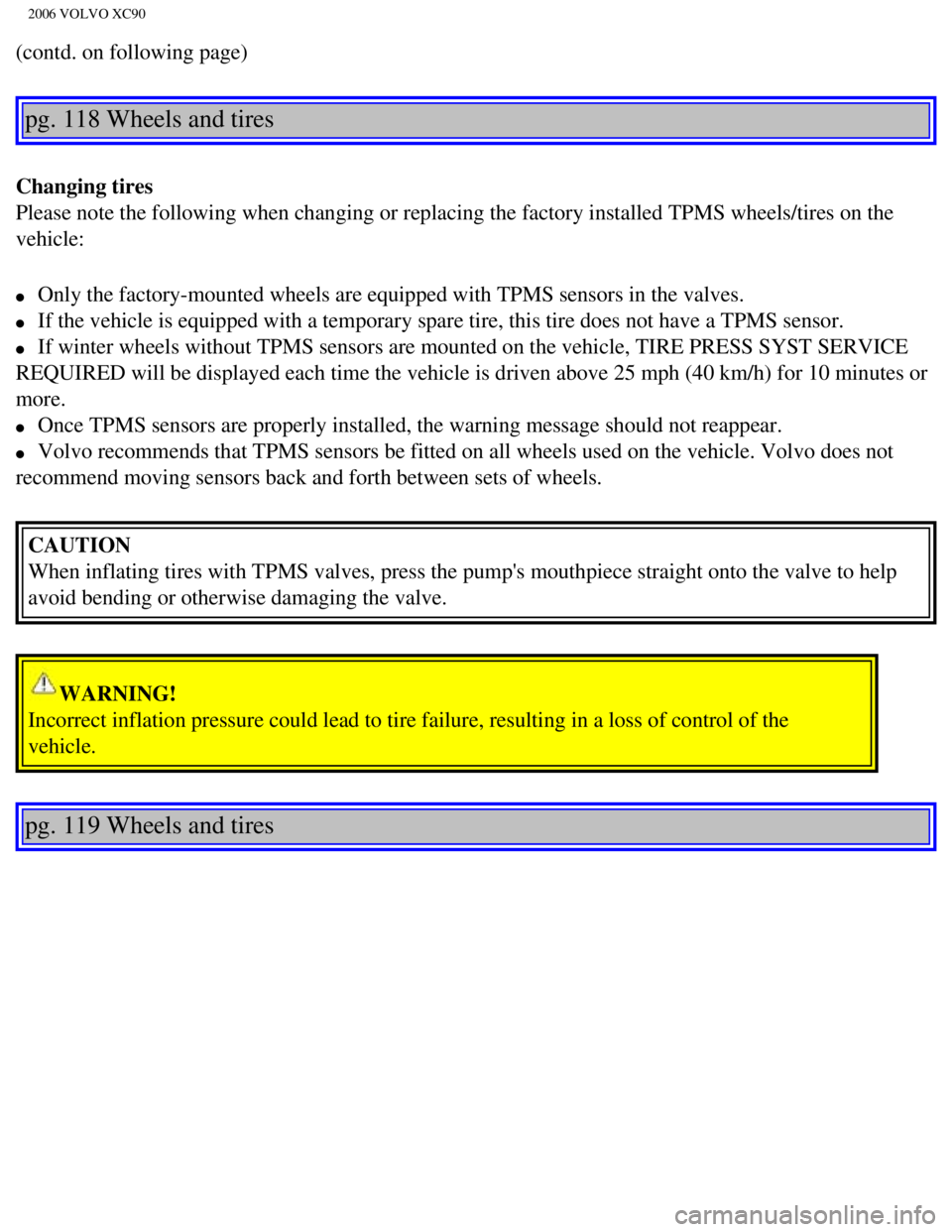
2006 VOLVO XC90
(contd. on following page)
pg. 118 Wheels and tires
Changing tires
Please note the following when changing or replacing the factory install\
ed TPMS wheels/tires on the
vehicle:
l Only the factory-mounted wheels are equipped with TPMS sensors in the va\
lves.
l If the vehicle is equipped with a temporary spare tire, this tire does n\
ot have a TPMS sensor.
l If winter wheels without TPMS sensors are mounted on the vehicle, TIRE P\
RESS SYST SERVICE
REQUIRED will be displayed each time the vehicle is driven above 25 mph \
(40 km/h) for 10 minutes or
more.
l Once TPMS sensors are properly installed, the warning message should not\
reappear.
l Volvo recommends that TPMS sensors be fitted on all wheels used on the v\
ehicle. Volvo does not
recommend moving sensors back and forth between sets of wheels.
CAUTION
When inflating tires with TPMS valves, press the pump's mouthpiece strai\
ght onto the valve to help
avoid bending or otherwise damaging the valve.
WARNING!
Incorrect inflation pressure could lead to tire failure, resulting in a \
loss of control of the
vehicle.
pg. 119 Wheels and tires
file:///K|/ownersdocs/2006/2006_XC90/06xc90_08.htm (9 of 22)12/30/2006\
5:32:49 PM
Page 206 of 256
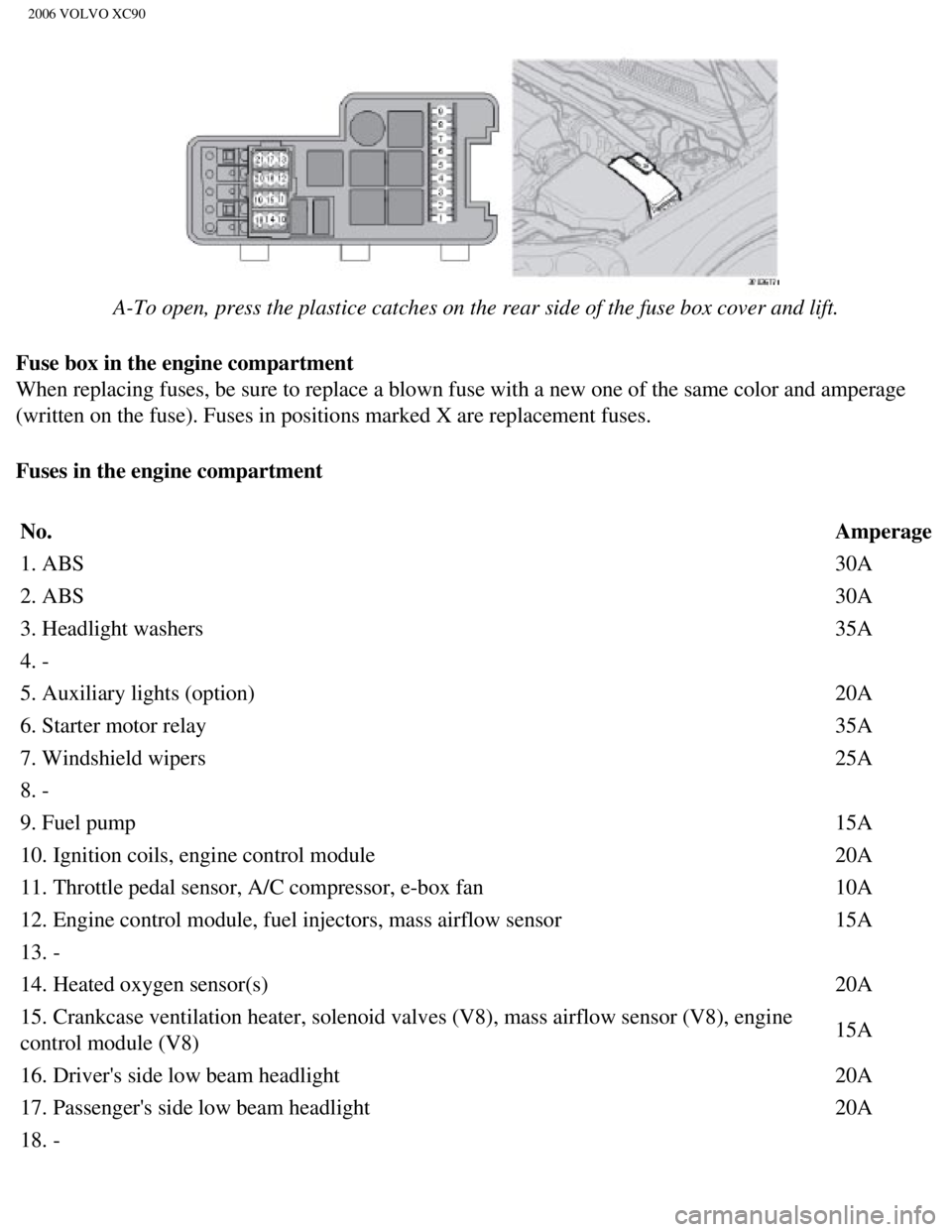
2006 VOLVO XC90
A-To open, press the plastice catches on the rear side of the fuse box c\
over and lift.
Fuse box in the engine compartment
When replacing fuses, be sure to replace a blown fuse with a new one of \
the same color and amperage
(written on the fuse). Fuses in positions marked X are replacement fus\
es.
Fuses in the engine compartment
No. Amperage
1. ABS 30A
2. ABS 30A
3. Headlight washers 35A
4. -
5. Auxiliary lights (option) 20A
6. Starter motor relay 35A
7. Windshield wipers 25A
8. -
9. Fuel pump 15A
10. Ignition coils, engine control module 20A
11. Throttle pedal sensor, A/C compressor, e-box fan 10A
12. Engine control module, fuel injectors, mass airflow sensor 15A
13. -
14. Heated oxygen sensor(s) 20A
15. Crankcase ventilation heater, solenoid valves (V8), mass airflow s\
ensor (V8), engine
control module (V8) 15A
16. Driver's side low beam headlight 20A
17. Passenger's side low beam headlight 20A
18. -
file:///K|/ownersdocs/2006/2006_XC90/06xc90_09b.htm (18 of 24)12/30/20\
06 5:32:52 PM
Page 207 of 256
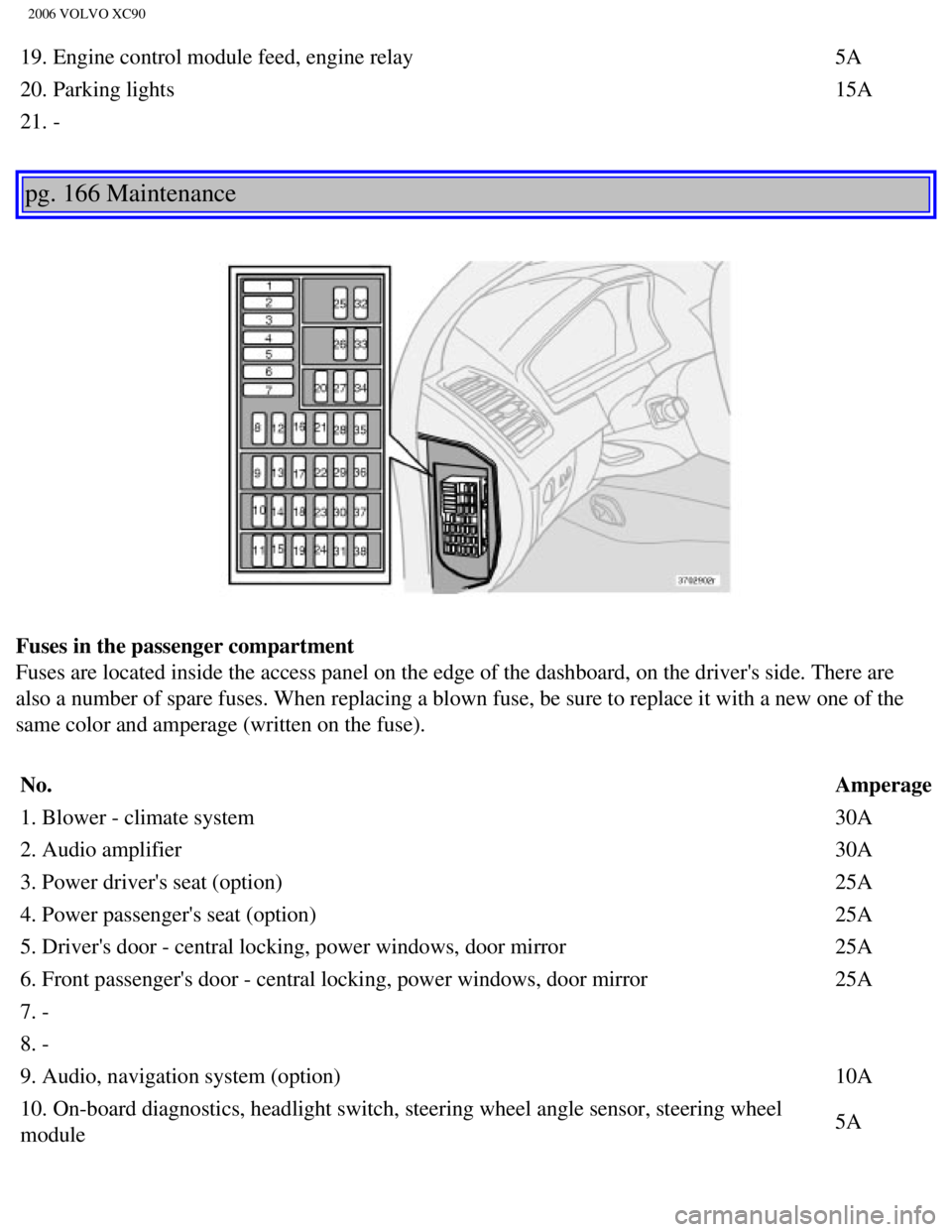
2006 VOLVO XC90
19. Engine control module feed, engine relay 5A
20. Parking lights 15A
21. -
pg. 166 Maintenance
Fuses in the passenger compartment
Fuses are located inside the access panel on the edge of the dashboard, \
on the driver's side. There are
also a number of spare fuses. When replacing a blown fuse, be sure to re\
place it with a new one of the
same color and amperage (written on the fuse).
No. Amperage
1. Blower - climate system 30A
2. Audio amplifier 30A
3. Power driver's seat (option) 25A
4. Power passenger's seat (option) 25A
5. Driver's door - central locking, power windows, door mirror 25A
6. Front passenger's door - central locking, power windows, door mirror \
25A
7. -
8. -
9. Audio, navigation system (option) 10A
10. On-board diagnostics, headlight switch, steering wheel angle sensor,\
steering wheel
module 5A
file:///K|/ownersdocs/2006/2006_XC90/06xc90_09b.htm (19 of 24)12/30/20\
06 5:32:52 PM